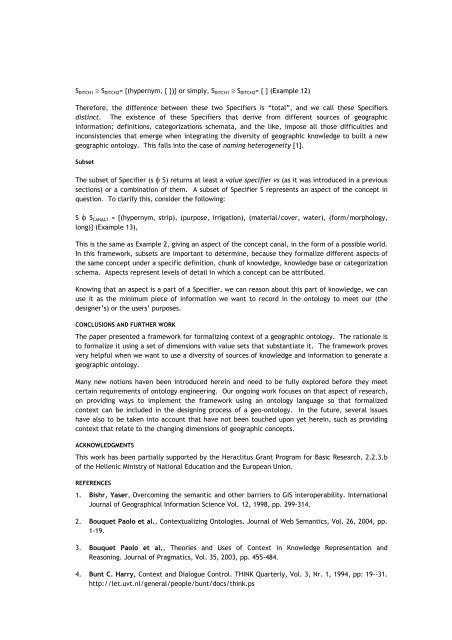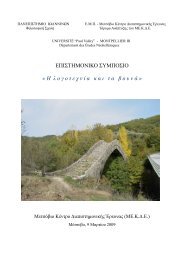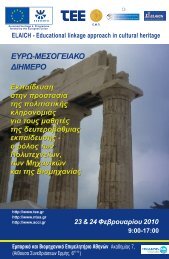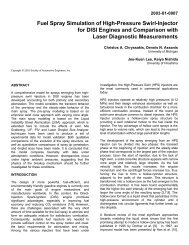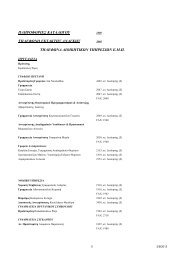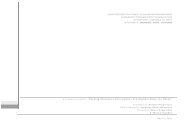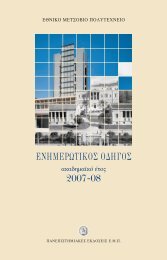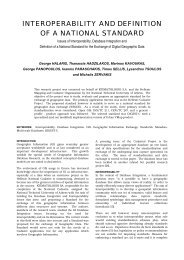CONTEXT IN GEOGRAPHIC KNOWLEDGE REPRESENTATION
CONTEXT IN GEOGRAPHIC KNOWLEDGE REPRESENTATION
CONTEXT IN GEOGRAPHIC KNOWLEDGE REPRESENTATION
You also want an ePaper? Increase the reach of your titles
YUMPU automatically turns print PDFs into web optimized ePapers that Google loves.
S DITCH1 ≥ S DITCH2 = {(hypernym, { })} or simply, S DITCH1 ≥ S DITCH2 = { } (Example 12)Therefore, the difference between these two Specifiers is “total”, and we call these Specifiersdistinct. The existence of these Specifiers that derive from different sources of geographicinformation; definitions, categorizations schemata, and the like, impose all those difficulties andinconsistencies that emerge when integrating the diversity of geographic knowledge to built a newgeographic ontology. This falls into the case of naming heterogeneity [1].SubsetThe subset of Specifier (s φ S) returns at least a value specifier vs (as it was introduced in a previoussections) or a combination of them. A subset of Specifier S represents an aspect of the concept inquestion. To clarify this, consider the following:S φ S CANAL1 = {(hypernym, strip), (purpose, irrigation), (material/cover, water), (form/morphology,long)} (Example 13),This is the same as Example 2, giving an aspect of the concept canal, in the form of a possible world.In this framework, subsets are important to determine, because they formalize different aspects ofthe same concept under a specific definition, chunk of knowledge, knowledge base or categorizationschema. Aspects represent levels of detail in which a concept can be attributed.Knowing that an aspect is a part of a Specifier, we can reason about this part of knowledge, we canuse it as the minimum piece of information we want to record in the ontology to meet our (thedesigner’s) or the users’ purposes.CONCLUSIONS AND FURTHER WORKThe paper presented a framework for formalizing context of a geographic ontology. The rationale isto formalize it using a set of dimensions with value sets that substantiate it. The framework provesvery helpful when we want to use a diversity of sources of knowledge and information to generate ageographic ontology.Many new notions haven been introduced herein and need to be fully explored before they meetcertain requirements of ontology engineering. Our ongoing work focuses on that aspect of research,on providing ways to implement the framework using an ontology language so that formalizedcontext can be included in the designing process of a geo-ontology. In the future, several issueshave also to be taken into account that have not been touched upon yet herein, such as providingcontext that relate to the changing dimensions of geographic concepts.ACKNOWLEDGMENTSThis work has been partially supported by the Heraclitus Grant Program for Basic Research, 2.2.3.bof the Hellenic Ministry of National Education and the European Union.REFERENCES1. Bishr, Yaser, Overcoming the semantic and other barriers to GIS interoperability. InternationalJournal of Geographical Information Science Vol. 12, 1998, pp. 299-314.2. Bouquet Paolo et al., Contextualizing Ontologies. Journal of Web Semantics, Vol. 26, 2004, pp.1-19.3. Bouquet Paolo et al., Theories and Uses of Context in Knowledge Representation andReasoning. Journal of Pragmatics, Vol. 35, 2003, pp. 455-484.4. Bunt C. Harry, Context and Dialogue Control. TH<strong>IN</strong>K Quarterly, Vol. 3, Nr. 1, 1994, pp: 19--31.http://let.uvt.nl/general/people/bunt/docs/think.ps


